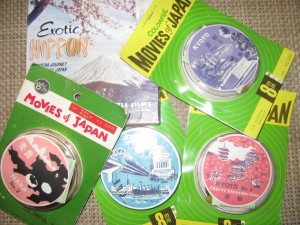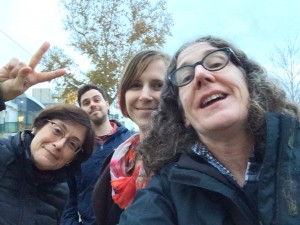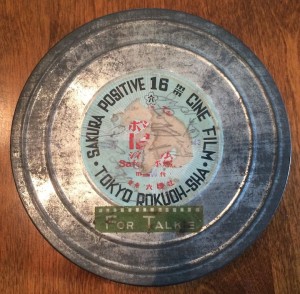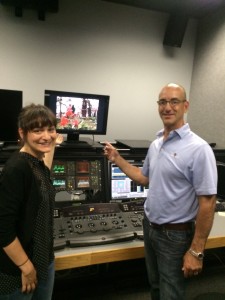The home page has been updated to reflect recent and upcoming developments in the direction of Re-Envisioning Japan. Starting in September 2015 the REJ physical collection will be transferred to the Rare Books, Special Collections and Preservation department of the University of Rochester River Campus Libraries, which will enable both long-term preservation and broader access. The digital project will migrate to Omeka, a platform that will allow for increased functionality and better expose the research underlying this project.
About
Follow Re-Envisioning Japan (3.13.15)
Here are a couple of other ways you can follow updates and announcements related to this project, including information about relevant film preservation projects or tourism in Japan: an Education page on Facebook at ReEnvisioning Japan at University of Rochester and on twitter, Joanne Bernardi@ReEnvisionJapan.
SUPER 8mm TIMELINE NOW AVAILABLE (2.24.15)

Sungraph Super 8mm films
The Super 8mm timeline is now up, featuring films from 1960-1981. Most of the films date from (were distributed in) the 1970s. These include a number of Sungraph films of Kyoto, Nara, Tokyo and Mt. Fuji that were apparently sold as souvenirs, packaged with the title “Movies of Japan” (left). They were unopened when I purchased them. The color is faded, but otherwise they were in good condition. The seller informed me that they were part of an estate sale.
One film on the timeline, “Hong Kong/Chinese Street Scenes” was mislabeled as being about Japan, but I decided to include it on the timeline nevertheless. Other notable films on the timeline include The Japanese Earthquake of September 1, 1923, Kamikaze Attack at Okinawa, and “Japanese Rice Cakes While You Wait” (Fox Movietone excerpt), all marketed by Blackhawk Films for home viewing. I am grateful to David Shepard (Film Preservation Associates) for allowing me to post them on this site. Defeat of Japan was distributed by Mountain Films in the UK, issued as part of their “War Series.” The makers of “Japan 1970” and “1981 Trip to Kyoto” are unknown; they are amateur home movies and fall into the category of orphan works.
I made the Fuji Single 8mm film Gion Festival, which documents the Kyoto Gion Festival (祇園祭) that takes place in that city every year on July 17th. The film begins with the building of the yama and hoko (山鉾) processional floats in the city streets and continues with the subsequent festivities at Yasaka Shrine (八坂神社), the eve of the procession, or yoiyama (宵山) and the procession itself, the yamaboko junkō (山鉾巡行) on the 17th. I shot most of the footage in 1976 while I was a student at the Osaka University of Arts, but I re-edited the film in 1977 when I returned to the Kansas City Art Institute (where it was judged as “too slow-paced.”) Gion Festival had a soundtrack that I recorded separately in which I provided a history of the festival. The film used was Fuji Single 8 color film, virtually analogous to Kodak Super 8mm, but using a differently designed cartridge for use in Fuji cameras.
The film Exotic Nippon in the upper left hand corner of the photograph above is a Castle Films release, also distributed for the home viewing market. That film will be added to the site along with the other Regular 8mm films in the Re-Envisioning Japan collection that are currently being scanned by Selznick MA student Sophia Lorent at George Eastman House’s Moving Image Department on a custom made piece of equipment .
PLATFORM UPDATE (and a minor glitch), 1.8.15
We just updated to the latest version of WordPress (4.1 “Dinah,” in honor of jazz singer Dinah Washington), but this caused a small glitch in the NextGEN gallery plugin that I thought was worth mentioning here. It really only affects galleries containing postcards: temporarily, until this glitch is solved, you might see a postcard appearing out of order within a gallery. For example, under “Commemorative,” a red cross postcard has usurped the order of the Nogi funeral commemorative postcard set, and the latest item addition to the “Expos and Fairs” postcard gallery appears before the genre marker for “postcards.” If you don’t notice these small aberrations, then the problem has been solved!
REJ FEATURED IN UR “RESEARCH CONNECTIONS” (12.13.14)
Re-Envisioning Japan is featured in the University of Rochester ‘s online “Research Connections,” in the Friday 5 December 2014 issue (Part 1) and in the Friday 12 December 2014 issue (Part 2).
REJ AT THE FREEDMAN CENTER FOR DIGITAL SCHOLARSHIP (11.15.14)

Left to right: Joanne Bernardi, Joshua Romphf, Lisa Wright, Nora Dimmock
On 5 November, I embarked on a road trip to Cleveland with Nora Dimmock (Assistant Dean for IT, Research, and Digital Scholarship, UR River Campus Library), Lisa Wright and Joshua Romphf (both from the UR Digital Humanities Center). Our destination was Case Western Reserve University, where its Freedman Center for Digital Scholarship at the Kelvin Library was sponsoring the Digital Scholarship Colloquium 2014: Pedagogy and Practices (6-7 November). Our panel, “Re-Envisioning Japan: A Faculty-DH Center Collaboration,” had been accepted for a morning slot on 6 November.
We began with my paper, “Introducing Re-Envisioning Japan,” which gave an overview of the project: Re-Envisioning Japan‘s development as technologically mediated scholarship; the way in which I use it as a teaching resource in my complementary “Tourist Japan” course; the rewards and challenges of building a Digital Humanities project; and plans for Re-Envisioning Japan’s development (a DH project is inherently ongoing). Nora Dimmock’s presentation, “Re-Envisioning Librarianship,” addressed the changing role of the research university library and its staff. She explained that for librarians, 21st century practice reflects a shift in priorities and a re-orientation toward a more collaborative relationship with faculty and their work. Library practice and faculty research increasingly involve seeking out and mastering different tools and new skill sets. Joshua Romphf demonstrated the layout and functionality of the new 16mm Timeline, and Lisa Wright detailed the workflow of scanning/photographing, editing, and digitization that results in a digital surrogate for the items in the Re-Envisioning Japan collection.
The colloquium opened with an engaging keynote lecture by Dr. Paul Fyfe, Assistant Professor of English at North Carolina State University, “The Scale of Digital Pedagogy.” It was an excellent opportunity to learn about innovative ways in which Digital Humanities projects can reshape the learning process by facilitating alternative approaches to teaching and research.
THE 16MM TIMELINE AND MORE (10.31.14)
A great deal has happened since the update in July. The digitization of 16mm, Regular 8mm, and Super 8mm film prints, the subject of the July post, was completed in August. In September, the New York Public Library lent me their Digital Beta cam copy of their preservation print of Julien Bryan’s Japan (1957), a preservation completed in collaboration with the National Film Preservation Foundation. At this point all of the moving image digital files were uploaded to the River Campus Library server. On 26 September, the 16mm Timeline was completed with thumbnails for all 16mm prints. Twenty-three titles can be viewed at present; two titles are from the Internet Archive, because the prints that are in my collection are less complete or in worse condition than the versions already available for access there. I am waiting for copyright permission to post the remaining titles, or fair use excerpts of them. In the meantime, I will be posting descriptions for each title. Work on a similar Timeline for the Super 8mm films will begin soon.
The digitization of the Regular 8mm films is a separate process requiring different equipment. In September, Selznick MA student Sophia Lorent prepped these films while we waited for a new dual 8mm scanner to arrive at the Moving Image Department of George Eastman House. Sophia and fellow MA student Joshua Yocum have been scanning these films since this piece of equipment arrived 16 October.
Adding moving images to Re-Envisioning Japan has been the most labor-intensive process so far, but it has been extremely rewarding. The collection is full of surprises: who knew, for example, that the composer Tōru Takemitsu, who composed soundtracks to films of the Japanese New Wave, also scored a 1961 film for the Japan External Trade Organization (Japan Today: The Spring of Energy)? The 16mm titles were made between approximately 1920 and 1981, and encompass a range of genres including educational titles, an amateur film, news documentaries, television commercials, a reel of film labeled “stock footage,” and cartoons.
“MISSION: KODAK DROP-OFF” (7.19.14)
My first substantive blog post for this website coincides with the massive project that has consumed the better half of this summer, making sense of my film collection. When I began this project, collecting films was not a priority, despite my background in film studies. There were good reasons for this at the time: for one, I began this project intending to explore new territory in terms of both media and method of research. That all changed when an internet collector colleague alerted me to an intriguing 16mm film can for sale with a Sakura film label. When the can arrived at my doorstep, I was startled to find a reel of film inside. This turned out to be reel 2 of Women in Japan (日本の女性, Japan 1941), and it was readily apparent that it was in an advanced stage of decomposition (visibly warped, with the pungent odor of “vinegar syndrome,” or acetate film base degradation). This film has a unique background that has been researched by film scholar Ikegawa Reiko, and it warrants a post of its own. This event was the primary factor in my decision to take a year off from work to attend the L. Jeffrey Selznick Program of Film Preservation at George Eastman House International Museum of Photography and Film here in Rochester. This was also the beginning of my film collection, which to date includes approximately 150 16mm, Regular 8mm, and Super 8mm titles.
In April I received funds from the University of Rochester to digitize the most relevant titles in the collection for this website. As a start, Selznick school alum and soon-to-be Visual and Cultural Studies graduate student Almudena Escobar López did preliminary research on the 16mm titles and prepped them for transfer, and on 12 June we drove the trunkful of reels to Kodak’s Entertainment Industry Digital Systems Laboratory. This resource was also, fortunately, “just up the road.” It goes without saying that this part of the project would have been much more involved and costly had I lived elsewhere. [1.1.16 update: this former Kodak facility is now the George Eastman Museum Digital Laboratory].
Almudena and I were concerned about the feasibility of transferring several of the 16mm titles. In addition to Women in Japan, there were a few other reels that were visibly warped, and a number of the (primarily Eastman) color films were faded.
When we arrived at the lab, however, Kodak Senior Colorist Kyle Alvut put a faded color reel on his Spirit DataCine film scanner and showed us how he could recover the latent color data of faded prints with the da Vinci color corrector. The moment I saw the revived color on the monitor I had an epiphany that changed my feelings toward the piles of film cans that had taken up residence in our dining room over the past 5-6 years (prompting my husband to refer to our home decor sensibility as “Early Archival”).
While waiting for the 16mm films to be digitized, I did some preliminary research on the Super 8mm and Regular 8mm film titles and prepped the Super 8mm titles for Kyle. (The Regular 8mm titles will be transferred at George Eastman House.) I also tackled copyright issues–more complex for the 16mm titles than for the smaller gauges–head-on. This is the most bewildering research I’ve had to do to date for this project; I have had to make peace with the fact that the process is more often than not inherently open-ended. Two weeks after we left the 16mm titles with Kyle he called to say that he’d finished the transfers and I could pick everything up after the 4th of July weekend.
Since then, I have been going over the 50-odd digitized titles one by one, checking credits, length, and other data against the Film Condition Reports that Almudena prepared while prepping the films last month. I’ve also been able to do some sleuthing on a few of the more obscure titles, such as the two missionary films, Kyoto Story (US, ca. 1950) and Kyoto Saturday Afternoon (US, ca. 1952) and one complete outlier, a film made by the Philadelphia Dairy Council (ca. 1961), Lantern Serenade. I created a Facebook page for updates on my research progress, and I have been posting a few interesting details about the films as I work through them. The films were scanned at 1920×1080 un‐compressed with a pillar box to maintain the correct aspect ratio, using the da Vinci color corrector to recover the color of faded prints. Scans were made at 24fps, with some dust busting to clean each film of artifacts. An Apple pro res 4:2:2 HQ 1920×1080 file was made for each film.
In the throes of copyright research, I declared that the summer I decided to watch all the Godzilla movies back to back was “much, much, much more fun,” but in truth it has been exhilarating to experience these films coming alive again.



